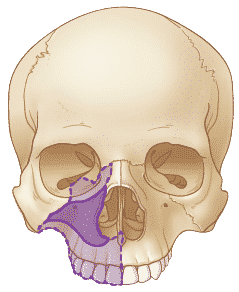Maxillectomy
What is maxillectomy?
 A surgical procedure called maxillectomy involves removing the upper jaw (maxilla) and a tumor located in the roof of the mouth (hard palate).
A surgical procedure called maxillectomy involves removing the upper jaw (maxilla) and a tumor located in the roof of the mouth (hard palate).
What are the goals of surgery?
The objectives of maxillectomy surgery vary depending on the pathology treated and the type of surgery (partial or total). The general objectives of maxillectomy are as follows:
Tumor elimination: Treatment of cancers of the maxillary sinus, maxilla, orbits and ethmoids that cannot be extirpated by a less significant resection or endonasal route is often indicated by maxillectomy.
Resection of adjacent structures: It is possible to extend the total maxillectomy to the orbital, sphenoid and pterigoid contents.
Restore standard proportions between the teeth: In the event of a dental occlusion disorder, surgery of the upper jaw and /or lower aims to reposition the dental arches.
What are the indications for a maxillectomy?
The indications for a maxillectomy are as follows:
Malignant or benign tumors on the hard palate or maxillary bone.
Significant maxillary trauma.
Persistent or recurrent inflammatory disorders.
Persistent infections, frequently linked to stone disease, affect the submandibular gland.
How does the surgery take place?
Typical steps of maxillectomy surgery include:
The procedure is carried out under general anesthesia.
Incision: To access the maxilla, the surgeon makes an incision in the gum of the upper ear.
Excision involves removing tumor tissue and part of the upper jaw.
Resection: If necessary, the surgeon resections nearby structures, such as the orbits, sphenoid bones and pterigoids.
The surgeon rests the dental arches during a partial maxillectomy to restore normal relationships between the teeth.
Suture: Absorbable stitches are used by the surgeon to suture incisions.
Recovery: In a few weeks, the suture dissolves and disappears from the body.
What is the duration of the intervention?
The duration of a maxillectomy varies depending on the complexity of the disease being treated and the surgical difficulties. The typical duration of the procedure is approximately one to two hours.
What are the surgical consequences?
The aftermath of a maxillectomy is generally painless and well controlled. The main operative outcomes after a maxillectomy are as follows:
The pain is not significant in the operated area.
Bleeding complications: There are only rarely bleeding complications requiring reoperation.
Although rare, infections can occur.
Oral asymmetry: Oral asymmetry can occur when smiling and speaking, but this is temporary and can be corrected quickly if the nerve is not damaged.
The slight depression under the jawline is due to the absence of the removed gland and gradually disappears.
What are the advantages ?
Malignant or benign tumors of the upper jaw can be removed by an operation called maxillectomy.
Resection of adjacent structures: maxillectomy can also resect adjacent structures like the orbits, sphenoids and pterigoids if necessary .
Improved quality of life: If the upper jaw has functional, aesthetic or health problems, a maxillectomy can be necessary.
What are the risks ?
Risk of infection: Although rare, infections can occur.
Risk of bleeding: There are only rarely bleeding complications requiring surgical reintervention.
Risk of recurrence: The lesional nature of the tumor can lead to recurrence.
Risk of pain: Pain in the area that was operated on is quite mild.
Risk of aesthetic complications: oral asymmetry can occur when smiling and speaking, but this is temporary and corrects quickly if the nerve is not damaged.
Risk of functional complications: It is possible to experience difficulty speaking, chewing or swallowing.
Risks associated with general anesthesia are rare, but can occur.
To reduce the risk of postoperative complications, maxillectomy should be performed by a qualified, competent and trained maxillofacial surgeon.
How does recovery work and how long does it last?
Recovery after a maxillectomy varies depending on the complexity of the procedure and how quickly the patient heals. The following should be considered for recovery:
Pain: Pain is usually moderate and can be relieved with pain medication.
Bleeding may persist for the next few days, especially during meals or oral hygiene.
It is advisable to rest for a few days after the surgery.
Work stoppage: Usually, a work stoppage of a few days to a week is permitted.
For a few days after the operation, it is advisable to avoid intense physical activities, intense sports, upside down activities and carrying heavy loads.
Hygiene: during the first days after the operation, it is crucial to maintain good hygiene of the mouth and not brushing your teeth.
Medical follow-up: Follow-up visits are scheduled to monitor healing and ensure everything is going well.